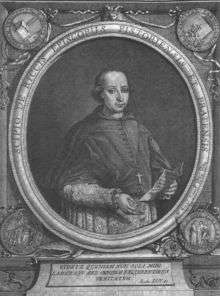Scipione de' Ricci

Scipione de' Ricci[1] (19 January 1741 – 27 January 1810) was an Italian Catholic prelate, who was bishop of Pistoia from 1780 to 1791. He was sympathetic to Jansenist ideas in theology.
Biography
Scipione de' Ricci was born in Florence,[2] of an eminent family. Giving early promise of worth and eminence, he was made Bishop of Pistoia and Prato, the most populous of the Tuscan dioceses, 19 June, 1780. He planned and energetically pursued, with the encouragement of Pius VI, the work of much-needed reform.[3]
With the support of Leopold I, Grand Duke of Tuscany, he attempted religious reforms, backed by the 1786 Synod of Pistoia.[4][5] There were models in Austrian Febronianism, and French Gallicanism. According to John Bertram Peterson, de’ Ricci's zeal bordered on recklessness.[3] He condemned devotion to the Sacred Heart, discouraged the use of relics and images, improvised liturgy, and founded a Jansenistic press.[3]
These moves however foundered, faced with eventual opposition from Pope Pius VI. Ricci had to leave Tuscany in 1790, as opposition grew, and resigned his see in 1791. In 1805 he submitted to Pope Pius VII.[6] He died on 28 December 1810, and is buried at Rignana, near Greve in Chianti.
Memoirs
De' Ricci's own memoirs, Memorie di Scipione de' Ricci, vescovo di Prato e Pistoia, edited by Antonio Galli, were published at Florence in two volumes in 1865. Besides this, his letters to Antonio Marini were published by Cesare Guasti at Prato in 1857; these were promptly put on the Index. See also De Potter, Vie de Scipion de Ricci (2 vols., Brussels, 1825), based on a manuscript life and a manuscript account of the synod placed on the Index in 1823. There are many documents in Zobi, Storia civile della Toscana, vols. ii. and iii. (Florence, 1856).
Portions of his memoirs were selectively published as an anti-Roman Catholic tract, edited in 1829 by Thomas Roscoe (with translation by Mr De Potter) under the title of Female Convents: Secrets of Nunneries Disclosed.[7]
Notes
- ↑ Scipione de Ricci, Scipione del Ricci, Scipio Ricci.
- ↑ The Cambridge History of Eighteenth-Century Political Thought, ed. Mark Goldie and Robert Wokler, Cambridge University Press, 2006, p. 769-70
- 1 2 3 Peterson, John Bertram. "Synod of Pistoia." The Catholic Encyclopedia Vol. 12. New York: Robert Appleton Company, 1911. 2 June 2017
- ↑ The Age of Absolutism and Unbelief: Febronianism and Josephism @ ELCore.Net
- ↑ Nicholas Terpstra (2002), The Politics of Ritual Kinship: Confraternities, p. 272.
- ↑

- ↑ Female Convents. Secrets of Nunneries Disclosed. by Scipione de' Ricci, D. Appleton and Company, New York, 1834.
![]()
Further reading
- Miller, S. J., 'The Limits of Political Jansenism in Tuscany', Catholic Historical Review, 80 (1994), pp. 762–7